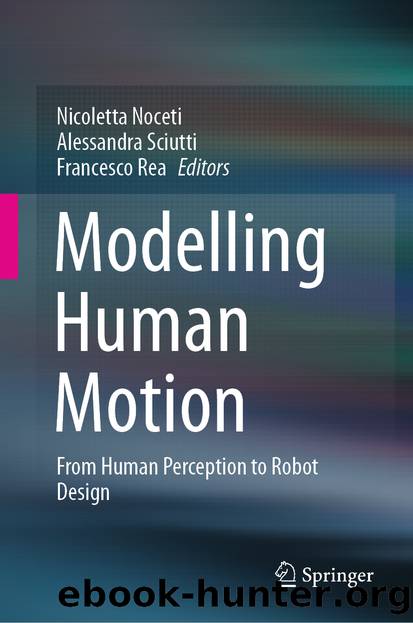Modelling Human Motion by Unknown

Author:Unknown
Language: eng
Format: epub
ISBN: 9783030467326
Publisher: Springer International Publishing
9.3.2 Non-rigid Registration
As described in the previous subsection, whenever a new RGBD frame (point cloud) becomes available, our scene model is non-rigidly warped from its previous state (that corresponds to the previous frame) to the new (current) observation. Since parts of the scene model may be invisible in the current state (e.g., because of self-occlusion), we cannot directly apply a traditional scene flow algorithm, as that would only provide us with motion estimates for (some of) the currently visible points. Instead, we adopt a more general approach, by implementing a non-rigid iterative closest point (ICP) algorithm, similar to [23–25].
As is the case with rigid ICP [41], our algorithm iterates between a correspondence search step and a warp field optimization step for the given correspondences. Our correspondence search typically amounts to finding the nearest neighbors of each point in the current frame to the model point cloud in its previous state. Correspondences that exhibit large point distance, normal angle, or color difference are discarded. Nearest neighbor searches are done efficiently by parallel kd-tree queries.
In the following, we will focus on the warp field optimization step of our scheme. It has been found that modeling the warp field using locally affine [23] or locally rigid [24] transformations provides better motion estimation results than adopting a simple translational local model, due to better regularization. In our implementation, for each point of the scene model in its previous state, we compute a full 6DOF rigid transformation that best aligns it to the current frame.
Let be the set of scene model points in the previous state that needs to be registered to the point set of the current frame, whose surface normals we denote by . Let and be the index sets of corresponding points in X and Y, respectively, such that is a pair of corresponding points. Let be the unknown warp field of rigid transformations, such that and , and Ti(xi) denotes the application of Ti to model point xi. Local transformations are parameterized by 3 Euler angles (α, β, γ) for their rotational part and 3 offsets (tx, ty, tz) for their translational part and are represented as 6D vectors .
Our goal at this stage is to estimate a warp field T, of 6 |X| unknown parameters, that maps model points in S as closely as possible to frame models in D. We formulate this property as the minimization of a weighted combination of sums of point-to-plane and point-to-point squared distances between corresponding pairs:
Download
This site does not store any files on its server. We only index and link to content provided by other sites. Please contact the content providers to delete copyright contents if any and email us, we'll remove relevant links or contents immediately.
Joan of Arc by Mary Gordon(4058)
Victory over the Darkness by Neil T. Anderson(2839)
The Gnostic Gospels by Pagels Elaine(2497)
Devil, The by Almond Philip C(2305)
The Nativity by Geza Vermes(2205)
The Psychedelic Gospels: The Secret History of Hallucinogens in Christianity by Jerry B. Brown(2137)
Going Clear: Scientology, Hollywood, and the Prison of Belief by Lawrence Wright(1961)
Going Clear by Lawrence Wright(1939)
A TIME TO KEEP SILENCE by Patrick Leigh Fermor(1882)
Barking to the Choir by Gregory Boyle(1807)
Old Testament History by John H. Sailhamer(1787)
Augustine: Conversions to Confessions by Robin Lane Fox(1754)
A History of the Franks by Gregory of Tours(1704)
A Prophet with Honor by William C. Martin(1703)
The Bible Doesn't Say That by Dr. Joel M. Hoffman(1667)
The Knights Templar by Sean Martin(1640)
by Christianity & Islam(1609)
The Source by James A. Michener(1581)
The Amish by Steven M. Nolt(1547)
